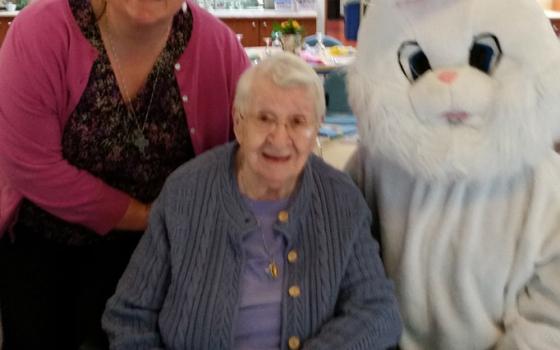We live in a world crying out for the joy, hope and peace of Easter.
It is a world challenged by what Pope Francis has called the "spiritual and moral abysses" facing humankind, "chasms that open up in hearts and provoke hatred and death." We cannot ignore this reality.
"Our world is full of persons suffering in body and spirit, even as the daily news is full of stories of brutal crimes which often take place within homes and large-scale armed conflicts which cause indescribable suffering to entire peoples," Pope Francis told the crowds gathered in St. Peter's Square on Easter Sunday in his annual "urbi et orbi" message. "Only God can fill those chasms with his love, prevent us from falling into them and help us to continue our journey together towards the land of freedom and life."
In the face of such suffering, against the backdrop of fear-mongering and terrorism, and with the soundtrack of an oftentimes toxic political debate, we celebrate Easter.
Christ is risen. Alleluia!
If Easter and the Resurrection are to mean anything, then we must be Easter people in such a world.
Of course, the Easter egg hunts and visits from the Easter Bunny are over. I shocked some non-church-going friends the other day when I told them that Easter is more than just one day, but as a liturgical season lasts 50 days, 10 more days than Lent!
The Scripture readings of this season challenge us to be Easter people. They are an antidote to apathy and food for the journey. Yes, it can be hard to find joy among such sorrow. However, as the Gospel stories of Jesus' appearance tell us, hope, joy and peace can break through in surprising ways, even through the darkness of our Good Fridays or the waiting and uncertainty of the Holy Saturdays of our lives. We also have the retelling of the stories in the Acts of the Apostles, featuring the first Easter people trying to be church in a mixed-up world. We follow in their footsteps and countless others' over the past 2,000-plus years.
One resource for prayer and reflection that I have turned to during the past few Easter seasons is a little book written in 1866 by the founder of my religious community, Margaret Anna Cusack, known as Mother Francis Clare. She was a prolific writer in her day, and in Meditations for Advent and Easter, she offers daily reflections for the Easter season. Her reflections are certainly grounded in the theology of her time, yet there is much in them that also challenges and inspires me today.
Reflecting on the account of Mary Magdalene at the tomb in John's Gospel, she writes:
Represent to yourself the faithful Magdalen weeping because she can no longer find Him who is her only joy. Pray that henceforth you may only weep for and with Jesus, and that you may only seek Him alone in all places and occupations. The disciples go home when they find the sepulcher empty; even the faithful Peter and the loving John are content with "looking in and seeing the linen clothes," but Magdalen stands without weeping. If she cannot see Jesus, she will at least remain where she knows He has been.
It can indeed be difficult to find joy in the empty-tomb moments of our lives. The heaviness of pain, sorrow and uncertainty can overwhelm us. But love remains, even in darkness. Mary Magdalene does not ignore the mixed-up feelings of the empty tomb. She stands there weeping, held by the memory of joy. Love leads her to the place where she can eventually see beyond her tears to see the risen Christ in her midst and experience joy once again.
Lamentation is key to being Easter people. We cannot ignore that which causes sorrow, but rather must engage the root causes of suffering even as we mourn with those who are most affected. In our heart of hearts, we also know that sorrow is not the end of the story.
As Easter people, we are, perhaps inexplicably, people of hope. As Margaret Anna Cusack reflects in one of her Easter meditations: "Cast the anchor of hope into the Heart of love, and all things shall work together for our eternal well-being."
Liberation theologian Gustavo Gutierrez writes about what he calls "a hermeneutic of hope." We must see with the eyes of hope, even into the darkest moments and places in our world. "Hope does not exist in a moment; we must create hope. Hope is a gift, a grace, and when we receive a gift, it is not for us; it is for our neighbor. To welcome the grace of hope is to create resources in history."
As Easter people, we must be creators of hope in our families, communities, and within our own hearts. God works through our hope, filling the chasms and bridging the divides.
Finally, as Easter people, we are called to be builders of peace. Peace, too, is a gift. My religious community's constitutions begin with this realization: "Peace is God's gift to us, given in Christ, a gift we experience and enjoy now, though not in its completeness." Indeed, the Sisters of St. Joseph of Peace were founded in 1884 to promote peace in family life, in the church, and in society.
I was amazed and delighted to see this understanding of peace as a gift mirrored in Margaret Anna Cusack's 1866 reflection on the description in John's Gospel of the appearance of Jesus to the disciples in the locked room:
Listen to the words He addresses to His disciples: "Peace be to you." When Jesus stands in the midst there must be peace; and peace of heart is a Christian privilege, a resurrection gift, of which none can deprive us unless we willfully deprive ourselves of it.
Just as the gift of hope is not for us, but for our neighbor, so too is the gift of peace.
As Easter people, we are called to find joy, to create hope, and to build peace.
Through us, the Easter story continues.
[Susan Rose Francois is a member of the Congregation Leadership Team for the Sisters of St. Joseph of Peace. She was a Bernardin scholar at Catholic Theological Union and has ministered as a justice educator and advocate. Read more of her work on her blog, At the Corner of Susan and St. Joseph.]

